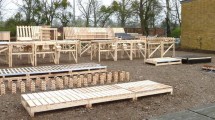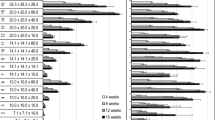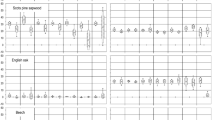Abstract
Natural durability of wood is determined by the European standard EN 252 for specimens in ground contact and EN 113 for basidiomycetes in the laboratory, but no test exists for above ground conditions. For above ground conditions, the European prestandard ENV 12037 and EN 330 are used to determine the durability of treated wood. The most important factors for fungal establishment on the surface and within wood are the moisture content, the surrounding temperature, and the relative humidity. Strength tests are the most sensitive for decay detection, but neither strength tests nor identification of fungi responsible for the decay are included in the standards of above ground durability in field tests. To detect decay, visual examination, pick or splinter tests, and mass loss determination are used. Identifying fungi with traditional methods, e.g., growth on solid medium, is time consuming and complicated. Molecular methods like polymerase chain reaction and sequencing do not require mycological skill for identification to species level, and furthermore the methods do not depend on the subjective judgement like most traditional methods, but are based on the objective information of the target organism (e.g., nucleotide sequences). The next generation of standard field tests will probably consider the drawbacks of standard tests today and be rapid and include both quality tests like molecular identification and nondestructive quantitative tests, e.g., acoustic tests. Laboratory tests can be improved by using fungi identified from field trials and by combining different fungi in the same test and thus simulate degradation in practice.
Article PDF
Similar content being viewed by others
Explore related subjects
Discover the latest articles, news and stories from top researchers in related subjects.References
CEN (1994) EN 350-1 Durability of wood and wood-based products. Natural durability of solid wood. Part 1. Guide to the principles of testing and classification of the natural durability of wood. European Committee for Standardisation., Brussels, Belgium
RA Eaton MDC Hale (1993) Wood, decay, pest and protection Chapman and Hall London 546
Öqvist H (1988) The durability of outdoor wood, field test: wood-panels exposure out of ground contact. Department of Forest Products, Uppsala, Sweden, p 38
Willeitner H, Peek R-D (1997) The natural durability story. International Research Group on Wood Preservation, Document No. IRG/WP 97-20119, p 14
TC Scheffer (1966) ArticleTitleNatural resistance of wood to microbial deterioration Annu Rev Phytopathol 4 147–168
Henningsson B, Käärik A (1982) Survey of decay fungi in window joinery (in Swedish). Swedish Wood Preservation Institute, Stockholm, Sweden, pp 1–52
TL Highley (1995) ArticleTitleComparative durability of untreated wood in use above ground Int Biodeter Biodegr 35 409–419
Henningsson B, Bergman Ö (1995) Above ground testing of wood preservatives – some experience from Sweden. International Research Group on Wood Preservation, Document No. IRG/WP 95-20079, p 5
WE Eslyn TL Highley FF Lombard (1985) ArticleTitleLongevity of untreated wood in use above ground Forest Prod J 35 28–35
Johansson P, Jermer J, Johansson I (2001) Field trial with wood preservatives for class AB (in Swedish). SP Swedish National Testing and Research Institute, Borås, Sweden pp 1–40
de Groot RC, Highley TL (1995) Forest products laboratory methodology for monitoring decay in wood exposed above ground. International Research Group on Wood Preservation, Document No. IRG/WP 95-20074, p 21
CEN (1993) EN 330 Wood preservatives. Field-test method for determining the relative protective effectiveness of awood preservative for use under acoating and exposed out-of-ground contact. L-joint method. European Committee for Standardisation Brussels, Belgium
CEN (1996) ENV 12037 Wood preservatives. Field test method for determining the relative effectiveness of awood preservative exposed out of ground contact. Horizontal lap-joint method. European Committee for Standardisation, Brussels, Belgium
CEN (1994) EN 350-2 Durability of wood and wood-based products. Natural durability of solid wood. Part 2. Guide to natural durability and treatability of selected wood species of importance in Europe. European Committee for Standardisation, Brussels, Belgium
CEN (1994) EN 460 Durability of wood and wood based products. Natural durability of solid wood. Guide to the durability of requirements for wood to be used in hazard classes. European Committee for Standardisation, Brussels, Belgium
CEN (1996) EN 113 Wood preservatives. Test method for determinating the protective effectivness against wood destroying basidiomycetes. Determination of the toxic values. European Committee for Standardisation, Brussels, Belgium
Borsholt E, Henriksen KH (1992) Guidelines for EN 252: field test method for determining the relative protective effectiveness of wood preservatives in ground contact. Nordic Wood Preservation Council, p 22
CEN (1992) EN 335-1 Classification of hazard classes. European Committee for Standardisation, Brussels, Belgium
CEN (1992) EN 335-2 Hazard classes of wood and wood-based products against biological attack. Part 2: Guide to the application of hazard classes to solid wood. European Committee for Standardisation, Brussels, Belgium
CEN (1995) EN 335-3 Durability of wood and wood-based products. Definition of hazard classes of biological attack. Part 3: Application to wood-based panels. European Committee for Standardisation, Brussels, Belgium
JW Deacon (1997) Modern mycology Blackwell Oxford 303
RA Zabel J Morrell (1992) Wood microbiology – decay and its prevention Academic San Diego 476
A Käärik (1974) Decomposition of wood CH Dickinson GJF Pugh (Eds) Biology of plant litter decomposition Academic New York 129–174
DD Nicholas D Crawford (2003) Concepts in the development of new accelerated test methods for wood decay B Goodell DD Nicholas TP Schultz (Eds) Wood deterioration and preservation: advances in our changing world American Chemical Society Washington 288–312
O Wälchli P Raschile (1983) The dry rot fungus – experience on causes and effects of its occurrence in Switzerland TA Oxley S Barry (Eds) Biodeterioration 5 J Wiley Chichester 749
WW Wilcox M Dietz (1997) ArticleTitleFungi causing above-ground wood decay in structures in California Wood Fiber Sci 29 291–298
M Dietz WW Wilcox (1997) ArticleTitleThe role of pre-infection of green Douglas-fir lumber in above ground decay in structures in California Forest Prod J 47 56–60
HA Viitanen (1997) ArticleTitleModelling the time factor in the development of brown rot decay in pine and spruce sapwood – the effect of critical humidity and temperature conditions Holzforschung 51 99–106
CG Carll TL Highley (1999) ArticleTitleDecay of wood and wood-based products above ground in buildings J Test Eval 27 150–158
Choi SM, Ruddick JNR, Morris PI (2003) Fungal colonization of CCA-treated decking. International Research Group on Wood Preservation, Document No. IRG/WP/03-10491, p 11
NJ Dix J Webster (1995) Fungal ecology Chapman and Hall London 560
WPK Findley (1965) ArticleTitleEcology of wood-destroying and wood-in-habiting fungi Holz Organ 1 199–211
Milberg P (1987) Microorganisms in buildings, a literature study of species, occurrence, and environmental demands (in Swedish). Department of Forest Products, Uppsala, Sweden, p 46
Viitanen H, Ritschkoff A-C (1991) Brown rot decay in wooden constructions. Effect of temperature, humidity and moisture. Department of Forest Products, Uppsala, Sweden, p 55
AO Rapp RD Peek M Sailer (2000) ArticleTitleModelling the moisture induced risk of decay for treated and untreated wood above ground Holzforschung 54 111–118
JJ Morrell (2002) ArticleTitleWood-based building components: what have we learned? Int Biodeter Biodegr 49 253–258
CR Curtis (1967) ArticleTitleResponse of fungi to diurnal temperature extremes Nature 213 738–739
Terziev N, Edlund M-L (2000) Attempt for developing a new method for above ground field testing of wood durability. International Research Group on Wood Preservation, Document No. IRG/WP 00-10199, pp 1–6
Sexton CM, Maristany AG, Brunner CC, Morrell JJ (1993) Using image analysis to rate wood stain trials. International Research Group on Wood Preservation, Document No. IRG/WP 93-10034, p 7
WW Wilcox (1978) ArticleTitleReview of literature on the effects of early stages on wood decay on wood strength Wood Fiber 9 252–257
WW Wilcox (1983) ArticleTitleSensitivity of the “pick test” for field detection of early wood decay Forest Prod J 33 29–30
JJ Morrell SM Smith MA Newbill RD Graham (1986) ArticleTitleReducing internal and external decay of untreated Douglas-fir poles – a field-test Forest Prod J 36 47–52
Henningsson B (1967) Changes in the impact bending strength, weight and alkali solubility following fungal attack on birch wood. Studia Forestalia Suecica, 41, Uppsala, Stockholm, p 21
Ruddick JNR (1986) Application of anovel strength evaluation technique during screening of wood preservatives. International Research Group on Wood Preservation, Document No. IRG/WP 2262, p 8
L Reinprecht Z Tiralova (2001) ArticleTitleSusceptibility of the sound and the primary rotten wood to decay by selected brown-rot fungi Drevarsky Vyskum 46 11–20
SF Curling CA Clausen JR Winandy (2002) ArticleTitleExperimental method to quantify progressive stages of decay of wood by basidiomycete fungi Int Biodeter Biodegr 49 13–19
JE Winandy JJ Morrell (1993) ArticleTitleRelationship between incipient decay, strength, and chemical composition of Douglas-fir heartwood Wood Fiber Sci 25 278–288
Morrell JJ, Rhatigan RG (2002) Ability of an acoustic inspection device to detect internal voids in untreated pole sections. International Research Group on Wood Preservation, Document No. IRG/WP 02-20246, p 8
RJ Ross VW Yang BL Illman WJ Nelson (2003) ArticleTitleRelationship between stress wave transmission time and bending strength of deteriorated oriented strandboard Forest Prod J 53 33–35
M Noguchi K Nishimoto Y Imamura Y Fujii S Okumura T Miyauchi (1986) ArticleTitleDetection of very early stages of decay in western hemlock wood using acoustic emissions Forest Prod J 36 35–36
J Van Acker H Militz M Stevens (1999) ArticleTitleThe significance of accelerated laboratory testing methods determining the natural durability of wood Holzforschung 53 449–458
J Van Acker M Stevens J Carey R Sierra-Alvarez H Militz I LeBayon G Kleist RD Peek (2003) ArticleTitleBiological durability of wood in relation to end-use. Part 1. Towards a European standard for laboratory testing of biological durability of wood Holz Roh Werkst 61 35–45
Rapp AO, Augusta U (2003) Some fundamental thoughts on the prediction of field performance from lab-testing based on comparison of lab and field results of some copper-free materials. International Research Group on Wood Preservation, Document No. IRG/WP/03-20269, p 15
McNamara WS (1994) Soil blocks versus field test for evaluating and standardizing wood preservatives: a commercial view. International Research Group on Wood Preservation, Document No. IRG/WP 94-20024, p 5
Nilsson T, Edlund M-L (1995) Laboratory versus field tests for evaluating wood preservatives: a scientific view. International Research Group on Wood Preservation, Document No. IRG/WP 95-20076, p 13
CA Jasalavich A Ostrofsky J Jellison (2000) ArticleTitleDetection and identification of decay fungi in spruce wood by restriction fragment length polymorphism analysis of amplified genes encoding rRNA Appl Environ Microb 66 4725–4734
J Jellison C Jasalavich (2000) ArticleTitleA review of selected methods for the detection of degradative fungi Int Biodeter Biodegr 46 241–244
RK Saiki DH Gelfand S Stoffel SJ Scharf R Higuchi GT Horn KB Mullis HA Erlich (1988) ArticleTitlePrimer-directed enzymatic amplification of DNA with a thermostable DNA polymerase Science 239 487–491
RK Saiki SJ Scharf F Faloona KB Mullis GT Horn HA Erlich N Arnheim (1985) ArticleTitleEnzymatic amplification of b-Globin genomic sequences and restriction site analysis for diagnosis of sickle cell anemia Science 230 1350–1354
V Edel (1998) Polymerase chain reaction in mycology: an overview PD Bridge DK Arora CA Reddy RP Elander (Eds) Application of PCR in mycology CAB International Wallingford 1–20
O Schmidt U Moreth (2000) ArticleTitleSpecies-specific PCR primers in the rDNA-ITS region as adiagnostic tool for Serpula lacrymans Mycol Res 104 69–72
O Schmidt U Moreth (1998) ArticleTitleCharacterization of indoor rot fungi by RAPD analysis Holzforschung 52 229–233
S Horisawa Y Sakuma K Takata S Doi (2004) ArticleTitleDetection of intra- and interspecific variation of the dry rot fungus Serpula lacrymans by PCR-RFLP and RAPD analysis J Wood Sci 50 427–432
NA White PK Dehal JM Duncan NA Williams JS Gartland JW Palfreyman DEL Cooke (2001) ArticleTitleMolecular analysis of intraspecific variation between building and ‘wild’ isolates of Serpula lacrymans and their relatedness to S. himantioides Mycol Res 105 447–452
O Schmidt U Moreth (1999) ArticleTitleIdentification of the dry rot fungus, Serpula lacrymans, and the Wild Merulius, S. himantioides, by amplified ribosomal DNA restriction analysis (ARDRA) Holzforschung 53 123–128
O Schmidt (2000) ArticleTitleMolecular methods for the characterization and identification of the dry rot fungus Serpula lacrymans Holzforschung 54 221–228
J Jellison C Jasalavich A Ostrofsky (2003) Detecting and identifying wood decay fungi using DNA analysis B Goodell DD Nicholas TP Schultz (Eds) Wood deterioration and preservation: advances in our changing world American Chemical Society Washington 346–357
Diehl SV, McElroy TC, Prewitt ML (2004) Development and implementation of a DNA-RFLP database for wood decay and wood associated fungi. International Research Group on Wood Preservation, Document No. IRG/WP 04-10527, p 18
N Kennedy N Clipson (2003) ArticleTitleFingerprinting the fungal community Mycologist 17 158–164
S Adair SH Kim C Breuil (2002) ArticleTitleA molecular approach for early monitoring of decay basidiomycetes in wood chips FEMS Microbiol Lett 211 117–122
N Högberg CJ Land (2004) ArticleTitleIdentification of Serpula lacrymans and other decay fungi in construction timber by sequencing of ribosomal DNA – a practical approach Holzforschung 58 199–204
Ray MJ, Dickinson DJ, Buck M (2004) Aureobasidium or Hormonema? A genetic approach. International Research Group on Wood Preservation, Document No. IRG/WP 04-10529, p 13
J Burnett (2003) Fungal population and species Oxford University Press Oxford 348
NS Lord CW Kaplan P Shank CL Kitts SL Elrod (2002) ArticleTitleAssessment of fungal diversity using terminal restriction fragment (TRF) pattern analysis: comparison of 18S and ITS ribosomal regions Fems Microbiol Ecol 42 327–337
TL Marsh (1999) ArticleTitleTerminal restriction fragment length polymorphism (T-RFLP): an emerging method for characterizing diversity among homologous populations of amplification products Curr Opin Microbiol 2 323–327
IA Dickie B Xu RT Koide (2002) ArticleTitleVertical niche differentiation of ectomycorrhizal hyphae in soil as shown by T-RFLP analysis New Phytol 156 527–535
O Schmidt U Moreth (2002) ArticleTitleData bank of rDNA-ITS sequences from building-rot fungi for their identification Wood Sci Technol 36 429–433
Carey JK, Purslow DF, Savory JG (1981) Proposed method for out-of-ground contact trials of exterior joinery protection systems. International Research Group on Wood Preservation, Document No. IRG/WP 2157, p 15
Dickinson DJ, Bravery AF, Carey JK (1982) Collaborative field trial out-of-ground contact. International Research Group on Wood Preservation, Document No. IRG/WP 2179, p 5
Van Acker J, Stevens M (1997) A new concept for the evaluation of wood for out of ground contact using accelerated L-joint testing. International Research Group on Wood Preservation, Document No. IRG/WP 97-20123, p 10
Carey JK (2002) L-joint trials. Part 1: observation on the process of colonisation and decay. International Research Group on Wood Preservation, Document No. IRG/WP/02-20250, p 14
Carey JK (2002) L-joint trials. Part 2: the relationship between colonisation by decay fungi and long term performance. International Research Group on Wood Preservation, Document No. IRG/WP/02-20251, p 10
Molnar S, Dickinson DJ, Murphy RJ (1997) Microbial ecology of treated lap-joints exposed at Hilo, Hawaii for 24 months. International Research Group on Wood Preservation, Document No. IRG/WP 97-20107, p 15
Fougerousse M (1980) An attempt to develop a direct and reliable method for testing the preventive action of preservation treatments of wood against fungal decay. International Research Group on Wood Preservation, Document No. IRG/WP 2139, p 29
Vidovic N (1981) Short-term field test method with accelerated infection of Basidiomycetes in wood. International Research Group on Wood Preservation, Document No. IRG/WP/2155, p 7
Johnson GC, Thornton JD, Creffield JW, Howick CD (1983) Natural durability studies in an accelerated field simulator – a novel approach. International Research Group on Wood Preservation, Document No.IRG/WP 2197, p 7
Déon GRY, Trong LN (1984) Window test direct testing of wood resistance to decay: a study of its fitness, its reliability and its accelerating factor. International Research Group on Wood Preservation, Document No. IRG/WP/2219, p 12
Ruddick JNR (1989) Are fungal cellar tests really necessary? International Research Group on Wood Preservation, Document No. IRG/WP/2333, p 5
Polman JE, Michon SGL, Militz H (1991) Accelerated wood decay in asoil bed test under greenhouse conditions compared with astake test under field condition. International Research Group on Wood Preservation, Document No. IRG/WP/2384, p 12
Rapp AO, Augusta U, Peek RD (2001) Facts and ideas of testing wood durability above ground. In Proceedings of COST E22, Reinbek, Germany, 2001, pp 1–5
Augusta U, Rapp AO (2003) The natural durability of wood in different use classes. International Research Group on Wood Preservation, Document No. IRG/WP/03-10457, p 15
Williams GR, Drysdale JA, Fox RF (1995) A note on testing the efficacy of wood preservatives above ground. International Research Group on Wood Preservation, Document No. IRG/WP 95-20078, p 5
Nilsson K (1993) Wood protection treatment – comparative tests of aselection of traditional and modern treatments (in Swedish). Swedish Wood Preservation Institute, Stockholm, Sweden, p 64
Author information
Authors and Affiliations
Corresponding author
About this article
Cite this article
Råberg, U., Edlund, ML., Terziev, N. et al. Testing and evaluation of natural durability of wood in above ground conditions in Europe – an overview. J Wood Sci 51, 429–440 (2005). https://doi.org/10.1007/s10086-005-0717-8
Received:
Accepted:
Issue Date:
DOI: https://doi.org/10.1007/s10086-005-0717-8




